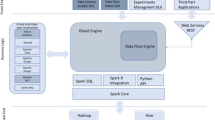Abstract
In this study, we propose an approach to build a detection model for surveillance of healthcare-associated urinary tract infection (HA-UTI) based on the variables extracted from the electronic medical records (EMRs) in a 730-bed, tertiary-care teaching hospital in Taiwan. Firstly we mapped the CDC’s HA-UTI case definitions to a set of variables, and identified the variables whose values could be derived from the EMRs of the hospital automatically. Then with these variables we performed discriminant analysis (DA) on a training set of the EMRs to construct a discriminant function (DF) for the classification of a patient with or without HA-UTI. Finally, we evaluated the sensitivity, specificity, and overall accuracy of the function using a testing set of EMRs. In this study, six surveillance variables (fever, urine culture, blood culture, routine urinalysis, antibiotic use, and invasive devices) were identified whose values could be derived from the EMRs of the hospital. The sensitivity, specificity and overall accuracy of the built DF were 100 %, 94.61 %, and 94.65 %, respectively. Since most hospitals may adopt their EMRs piece-by-piece to meet their functional requirements, the variables that are available in the EMRs may differ. Our approach can build a detection model with these variables to achieve a high sensitivity, specificity and accuracy for automatically detecting suspected HA-UTI cases. Therefore, our approach on one hand can reduce the efforts in building the model; on the other hand, can facilitate adoption of EMRs for HAI surveillance and control.
Similar content being viewed by others
References
Horan, T. C., Andrus, M., and Dudeck, M. A., CDC/NHSN surveillance definition of health care-associated infection and criteria for specific types of infections in the acute care setting. Am. J. Infect. Control. 36:309–332, 2008.
Klevens, R. M., Edwards, J. R., Richards, C. L., et al., Estimating health care-associated infections and deaths in U.S. hospitals, 2002. Public Health Rep 122:160–167, 2007.
Glenister, H. M., Taylor, L. J., Bartlett, C. L. R., et al., An evaluation of surveillance methods for detecting infections in hospital inpatients. J. Hosp. Infect. 23:229–242, 1993.
Atreja, A., Gordon, S. M., Pollock, D. A., et al., Opportunities and challenges in utilizing electronic health records for infection surveillance, prevention, and control. Am. J. Infect. Control. 36:37–46, 2008.
Schiffman, R. N., Brandt, C. A., Liaw, Y., and Corb, G. J., A design model for computer based guideline implementation based on information management services. J Am Med Inform Assoc 6:99–103, 1999.
Wright, M. O., Fisher, A., John, M., Reynolds, K., Peterson, L. R., and Robicsek, A., The electronic medical record as a tool for infection surveillance: Successful automation of device-days. Am. J. Infect. Control. 37:364–370, 2009.
Worth, A. P., and Cronin, M. T. D., The use of discriminant analysis, logistic regression and classification tree analysis in the development of classification models for human health effects. J Mol Struc (Theochem) 622:97–111, 2003.
Brossette, S. E., Hacek, D. M., Gavin, P. J., et al., A laboratory based, hospital-wide, electronic marker for nosocomial infection: the future of infection control surveillance. Am. J. Clin. Pathol. 125:34–39, 2006.
Broderick, A., Mori, M., Nettleman, M. D., Streed, S. A., and Wenzel, R. P., Nosocomial infections: validation of surveillance and computer modeling to identify patients at risk. Am. J. Epidemiol. 131:734–742, 1990.
Trick, W. E., Zagorski, B. M., Tokars, J. I., et al., Computer algorithms to detect bloodstream infections. Emerg. Infect. Dis. 10:1612–1620, 2004.
Wright, M. O., Perencevich, E. N., Novak, C., Hebden, J. N., Standiford, H. C., and Harris, A. D., Preliminary assessment of an automated surveillance system for infection control. Infect Control Hosp Epidemiol 25:325–332, 2004.
Graham, P. L., Gabriel, P. S., Lutwick, S., et al., Validation of a multicenter computer-based surveillance system for hospital-acquired bloodstream infections in neonatal intensive care departments. Am. J. Infect. Control. 32:232–234, 2004.
Evans, R. S., Pestotnik, S. L., Classen, D. C., et al., A computer-assisted management program for antibiotics and other antiinfective agents. N. Engl. J. Med. 338:232–238, 1998.
Bouam, S., Girou, E., Brun-Buisson, C., Karadimas, H., and Lepage, E., An internet-based automated system for the surveillance of nosocomial infections: prospective validation compared with physicians’ self-reports. Infect Control Hosp Epidemiol 24:51–55, 2003.
Chalfine, A., Cauet, D., Lin, W. C., et al., Highly sensitive and efficient computer-assisted system for routine surveillance for surgical site infection. Infect Control Hosp Epidemiol 27:794–801, 2006.
Evans, R. S., Burke, J. P., Classen, D. C., et al., Computerized identification of patients at high risk for hospital-acquired infection. Am. J. Infect. Control. 20:4–10, 1992.
Pokorny, L., Rovira, A., Martin-Baranera, M., Gimeno, C., Alonso-Tarres, C., and Vilarasau, J., Automatic detection of patients with nosocomial infection by a computer-based surveillance system: a validation study in a general hospital. Infect Control Hosp Epidemiol 27:500–503, 2006.
McNamara, M. J., Hill, M. C., Balows, A., and Tucker, E. B., A study of the bacteriologic patterns of hospital infections. Ann. Intern. Med. 66:480–488, 1967.
Willard, K. E., Johnson, J. R., and Connely, D. P., Radical improvements in the display of clinical microbiology results. Am. J. Med. 101:541–549, 1996.
Brusaferro, S., Regattin, L., Faruzzo, A., et al., Surveillance of hospitalacquired infections: A model for settings with resource constraints. Am. J. Infect. Control. 34:362–366, 2006.
Acknowledgments
We thank the infection control team members at TMUWF for their support. We also thank Mr. James Andrew Worley for manuscript editing.
Financial Support
This research was partially supported by National Science Council (NSC) of Taiwan under the grant numbers NSC 97-2221-E-038-010 and NSC 98-2221-E-038-009-MY3.
Conflicts of interest
The authors declare that they have no conflict of interest.
Author information
Authors and Affiliations
Corresponding author
Rights and permissions
About this article
Cite this article
Lo, YS., Lee, WS. & Liu, CT. Utilization of Electronic Medical Records to Build a Detection Model for Surveillance of Healthcare-Associated Urinary Tract Infections. J Med Syst 37, 9923 (2013). https://doi.org/10.1007/s10916-012-9923-2
Received:
Accepted:
Published:
DOI: https://doi.org/10.1007/s10916-012-9923-2




